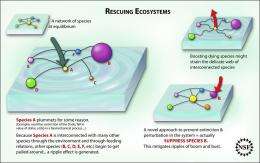Surprising approach could help rescue fragile ecosystems, halt cascades of extinctions

(PhysOrg.com) -- Feral pigs introduced to the Galapagos Archipelago shortly after Charles Darwin’s historical visit have damaged the ecosystem of Santiago Island, causing, it is believed, the extinction or imperilment of a number of species. The complete removal of the pigs 11 years ago is beginning to restore balance to the island.
Two Northwestern University scientists have developed a mathematical model that supports the management choices in perturbed ecosystems, such as the Galápagos, and illustrates how human intervention may effectively aid species conservation efforts. The selective suppression or removal of one or more species in a troubled ecosystem can save many more species.
The researchers developed their model that describes interactions within ecological food webs in an effort to better understand the dynamics of complex networks. The approach could be used to stabilize a wide array of complex networks, including ecosystems, financial networks, power grids and biochemical networks.
The results are published by the journal Nature Communications.
“Our study provides a theoretical basis for management efforts that would aim to mitigate extinction cascades in food web networks,” said Adilson E. Motter, associate professor of physics and astronomy at Northwestern’s Weinberg College of Arts and Sciences. “There is evidence that a significant fraction of all extinctions are caused not by a primary perturbation but instead by the propagation of a cascade.”
Motter and his graduate student Sagar Sahasrabudhe conducted the study and are authors of the paper, titled “Rescuing Ecosystems from Extinction Cascades Through Compensatory Perturbations.” They specifically looked at the Chesapeake Bay food web, an aquatic network with 33 species, and the Coachella Valley food web, a terrestrial network with 30 species.
Extinction cascades are often observed following the loss of a key species within an ecosystem. As the system changes to compensate for the loss, availability of food, territory and other resources to each of the remaining members can fluctuate wildly, creating a boom-or-bust environment that can lead to even more extinctions. According to the study, more than 70 percent of these extinctions are preventable, even under the stringent assumption that the food web is to be brought into balance using only resources already available in the system. (For example, no new organisms may be introduced.)
Motter explained further, “We find that extinction cascades can often be mitigated by suppressing -- rather than enhancing -- the populations of specific species. In numerous cases, it is predicted that even the proactive removal of a species that would otherwise be extinct by a cascade can prevent the extinction of other species.”
The finding may seem counterintuitive to conservationists because the compensatory actions seem to inflict further damage to the system. However, when the entire ecosystem is considered, the effect is beneficial. This news holds promise for those charged with maintaining Earth’s biodiversity and natural resources -- the health of which can counteract many of the causes of climate change as well as some man-made disasters such as the Gulf of Mexico oil spill.
The dodo bird, Raphus cucullatus, is one example of extinction due to human activity. The dodo was a large, flightless bird that became extinct in the 1600s. It is likely that a combination of factors including hunting, loss of habitat and perhaps even a flash flood, stressed the ecosystem on the island of Mauritius, home of the dodo. Some researchers think that human introduction of non-native species to the island, such as dogs, pigs, cats and rats, is what ultimately lead to the demise of the dodo.
In any case, in the future, it may be possible to avoid extinction of some species in stressed ecosystems by applying the new method of analysis developed by Motter and Sahasrabudhe.
The goal of this work is to develop mathematical methods to study dynamical processes in complex networks. Although the specific application mentioned here may be useful in management of ecosystems, the mathematical foundation underlying the analysis is much more universal. The broad concept is innovative in the area of complex networks because it concludes that large-scale failures can be avoided by focusing on preventing the waves of failure that follow the initial event.
This approach could be used to stabilize a wide array of complex networks. It can apply to biochemical networks in order to slow or stop progression of diseases caused by variations inside individual cells. It also can be used to manage technological networks such as the smart grid to prevent blackouts. It even can apply to regulation of complicated financial networks by identifying key factors in the early stages of a financial downturn, which, when met with human intervention, could potentially save billions of dollars.
The world is a complicated place that gets even trickier when trying to mathematically explain a complex network, especially when the network evolves within an environment that is itself changing. But, Motter says his mathematical model is promising for the study of changing environments.
“Uncertainty itself is not a problem,” Motter said. “The problem comes when you cannot estimate uncertainty.”
More information: www.nature.com/ncomms/index.html
Provided by Northwestern University














